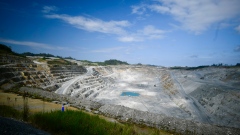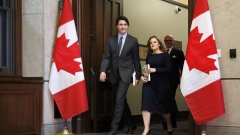Apr 28, 2024
Fading Bets of Early RBA Cuts Frustrate Albanese Reelection Plan
, Bloomberg News

(Bloomberg) -- Australian Prime Minister Anthony Albanese faces a bumpy road to reelection with sticky inflation pushing back the timetable for interest-rate relief, raising the prospect of further financial stress for households about a year from the next ballot.
The Reserve Bank will hold its cash rate at a 12-year high of 4.35% for most of 2024, with the odds of monetary easing now seen in November instead of September, according to the median estimate in a Bloomberg survey. At the start of the year, the talk in Canberra was that the Labor government may call an early election to ride the momentum of rate cuts anticipated in the second half.
Now, with at least one analyst — Capital Economics — predicting a hike at next week’s RBA meeting, prospects of an early relief from lower rates are fading. Money markets have switched from pricing in strong chances of a cut this year to now ascribing a near-60% probability of another 25-basis-point increase to 4.6% - a level last seen in October 2011.
Read more: RBA’s Guarded Policy Stance Highlights Sticky Inflation Worries
Australians are caught in a squeeze of rising prices and high borrowing costs, with a Resolve poll last week showing over half of respondents describing themselves as being on the brink of economic hardship. The survey finds that only 27% of voters trusted Labor on economic management, down from almost 40% two years ago.
The Labor government does have one ace up its sleeve, with tax cuts due to begin in July. But given that Australia has some of the world’s highest household debt, rate cuts are potentially more significant. With lingering inflation pressures, Treasurer Jim Chalmers faces a tricky balancing act when he hands down the annual budget on May 14.
“On the one hand, Labor would really like to stimulate economic growth,” said Zareh Ghazarian, a senior lecturer in politics at Monash University. “But on the other hand, any attempts to do so will presumably lift the inflation rate.”
Australia, like much of the developed world, had seen consumer prices steadily fall back from a 2022 peak, leading money markets to confidently price in rate cuts this year. But concerns that the “last mile” for inflation to return to the RBA’s 2%-3% target will take longer have now come to the fore.
The RBA raised rates 13 times between May 2022 and November 2023 to try to get control over inflation. Unlike the US, most households in Australia have floating-rate mortgages, meaning rate hikes flow quickly through to monthly repayments. Governor Michele Bullock recently highlighted that this makes RBA policy tightening much more potent.
“The risks to easing too soon, and so eroding inflation’s return to target, are significant and so it’s appropriate that the market now does not expect the RBA to cut rates this year,” said Jonathan Kearns, chief economist at money manager Challenger Ltd. and a former senior RBA official.
What Bloomberg Economics Says...
“Consumers are already very unhappy and that’s been prolonged already. Stretching it further could hurt the government.”
— James McIntyre, economist
For the full note, click here
One place where inflation pressures remain particularly acute is in housing rental costs, which at an annual 7.7% in the first quarter are around the highest level recorded in the 30 years that the RBA has targeted inflation.
Labor’s economic strategy of running a tight fiscal policy to buttress tight monetary policy and bring down inflation early in its term was based on the idea that, later on, a combination of tax cuts, lower rates and increased fiscal spending would ease the pain and smooth the path to reelection.
Labor is currently only narrowly ahead of the opposition Liberal-National coalition two years into its first term in office. The latest Newspoll survey showed Albanese’s party leading 51% to 49% on a two-party preferred basis.
Albanese currently holds power only by a couple of seats in Australia’s 151-member lower house of parliament and if an election was held today, Labor may be forced into minority government, relying on independent lawmakers and smaller parties to maintain its grip.
“If the government doesn’t have a positive story to tell in terms of its economic strategy, then convincing voters who are sitting on the fence becomes much harder,” said Ghazarian.
--With assistance from Tomoko Sato and Garfield Reynolds.
(Adds money market pricing, chart.)
©2024 Bloomberg L.P.








